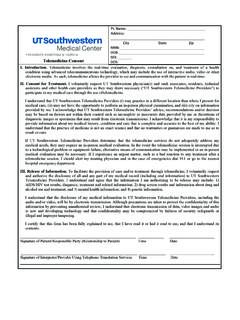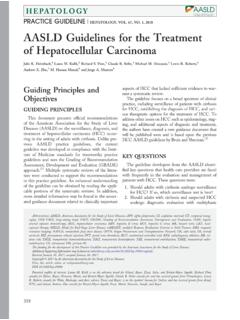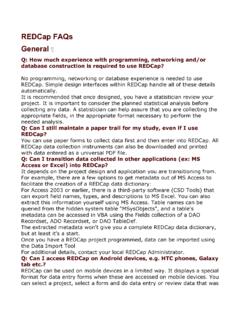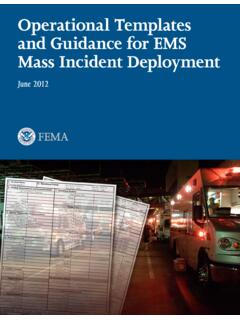Transcription of Ventilator Basics - UT Southwestern
1 Ventilator Basics all you need to know in just 2 pages! ;) Vents can get fairly complicated but all interns and residents rotating through the ICU should be able to understand the basic principles, settings, and modes used in our medical intensive care unit. This is our very basic overview, GL! Principles: C=V/P (Compliance=Volume/Pressure) (I remember this bc CVP ) o Very simple formula, but the main principle behind the Ventilator o Compliance = the Ventilator system itself, the airways, the lungs (the patient) Initially, consider compliance to be fixed.
2 However, appreciate that we diurese, optimize sedation and vent settings to improve comfort, and even paralyze a patient in part to improve compliance. These aspects are beyond the scope of this basic discussion. o Volume = this could be your DEpendent or INdependent variable, depending on your mode o Pressure = same as volume (it s either your dependent or independent variable), because you will always set either volume or pressure, not both (for this basic overview) The Ventilator does just 2 things: 1 it oxygenates, 2 it ventilates o Oxygenation: depends on MAP (mean airway pressure) and FiO2 MAP can be adjusted by.
3 PEEP (and inspiratory pressure if in pressure control mode) Adjusting the inspiratory time, which changes the proportion of time the vent system is at the higher, inspiratory pressure. o Ventilation: depends on tidal volume (Vt) and respiratory rate (RR) Note that, depending on your mode, you may set the volume or the volume may depend on pressure If your volume depends on pressure then the PEEP affects your ventilation as well (will explain below in mode section) Also consider: Physiologic dead space may effectively decrease tidal volume.
4 While generally accurate, the Vt is only what the machine reports. pH ~ bicarb/CO2 AKA pH is proportionate to the bicarb (measured on the BMP, NOT the ABG!) divided by the CO2 (measured on the ABG performed at a similar time to the BMP) o This principle is to help you adjust your Ventilator settings to adjust your pH (basically, ventilation) o The CO2 is dependent on the minute ventilation (volume of each breath x RR) o Adjust volume or RR (within reasonable limit) to increase or decrease CO2 Be aware that increasing RR will decrease the expiratory time, diminishing effective ventilation.
5 This is much more of a concern for patients with COPD. Modes: Assist Control, Volume Control (AC/VC): This is the mode we use most commonly here. Assist control means that you get the breaths set for you PLUS you get assisted (with the full settings) on breaths that you initiate yourself. Volume control means that in this mode, your volume is your INdependent variable, therefore making pressure your DEpendent variable. The inspiratory pressure is determined by the compliance of the system to accept that volume (going back to C=V/P)! o Settings: Volume/RR/PEEP/FiO2 (this is how you ll report the settings on daily rounds) Volume: At the most basic level we set the Vt at 6-8cc/kg for ideal height, however you should set Vt based on clinical scenario.
6 For patients with sepsis we lean towards ARDSnet settings but a patient with DKA will need higher minute ventilation and greater Vt. RR: If the patient was intubated primarily for hypoxemic respiratory failure, then consider setting the rate just below the patient s actual RR once they re intubated. Ideally watch the patient after intubation, and adjust the RR until they are initiating a few breaths themselves (RT can help you determine this). If the patient had an acidosis, increase their rate to achieve an appropriate minute ventilation that allows them to blow off adequate CO2.
7 If they re alkalemic, they should have a depressed respiratory drive, so they may just breathe with the machine until their pH normalizes. PEEP: Set based on ARDSnet. We generally start at a PEEP of 5 and adjust. There s a high PEEP/low FiO2 strategy and vice versa. Print out the ARDSnet protocol and keep it in your white coat pocket to help you out! (attached) FiO2: Also use ARDSnet as above. We generally start at 100% but you may start lower if the patient is not intubated for hypoxemia (for example, in DKA or AMS). One good tip, PaO2 should be about 5x the set FiO2 if the patient has NO lung problems.
8 Therefore, if your FiO2 is 20% (room air) your PaO2 should be 100. If your FiO2 is 100%, your PaO2 should be 500. Thus, if your patient is set on an FiO2 of 100% and their PaO2 is 100 - this is not good!!! >AC/VC o Things to check: MV, actual RR, peak and plateau pressures MV: You ll need to report your patients average minute ventilation over the night each AM on rounds It s important to know if your patient s pH has changed despite their MV being unchanged step 1, check the BMP to see if the changing pH is due to a metabolic cause; step 2, if this is not the case, look out for new dead space that may have been created by a PE or other lung pathology, be thoughtful!
9 RR: Always check your patient s ACTUAL RR, not just the SET RR!!! Peak pressure: In VC mode, peak pressure is always shown on the main screen of the vent (our goal is usually to keep this under 30-35) Plateau pressure: To check this, you ll need to perform an inspiratory hold During inspiratory hold, all valves remain closed after the full breath has been given, pressure measured at this time represents the pressure across the alveoli A difference in peak and plateau pressure indicates something is wrong with the system itself, tube, or large airways of the patient When both the peak and plateau pressures are elevated, this indicates a more parenchymal process is going on (remember C=V/P, high pressure means low compliance)
10 Or sometimes it just happens when the patient is obese Assist Control, Pressure Control (PC): In this mode, you set the pressure (INdependent variable) making volume your DEpendent variable. The delta pressure (difference in IPAP-EPAP determines your volume) and of course as always, compliance matters! C=V/P!!! This mode is more complicated at first, you probably need to ask for help from your resident/fellow/attending before setting this on your own. o Settings: IPAP/EPAP/RR/FiO2 IPAP: Inspiratory positive airway pressure. Set this to maintain the same goal volume as above, 6-8cc/kg.





